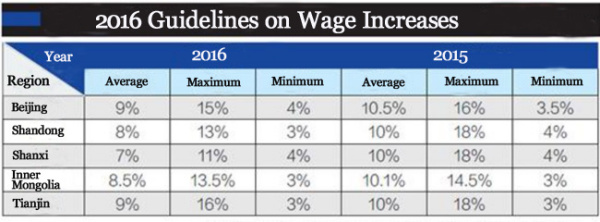
Five municipalities and provinces have issued their 2016 guidelines on wage increases, heralding a smaller wage increase this year as most wage growth rates fall, China Economic Weekly reports.
The newspaper, a subsidiary of People's Daily, reports that as of July, municipal governments in Beijing, Tianjin and the provincial governments in Shandong, Shanxi and the Inner Mongolia autonomous region have laid out the suggested wage increase levels for enterprises based on regional GDP, labor markets, and other socioeconomic conditions.
Guidelines on wage increases, introduced in 1997 in China, can be divided into three levels: average suggested wage increase, maximum suggested wage increase and minimum suggested wage increase.
Data shows that the average suggested wage increase of five regions all dropped to below 10 percent, with Shanxi having the biggest decline of 3 percent.
The maximum suggested wage increase fell noticeably. Shandong dropped to 13 percent from 18 percent last year and Shanxi goes down to 11 percent from last year's 18 percent.
Unlike average and maximum suggested wage increases, the minimum suggested wage increase adjusts according to different regions. Beijing increased 0.5 percent to 4 percent, Shandong edged down to 3 percent from 4 percent last year and others stayed the same.
Su Hainan, vice president of the China Association for Labor Studies, said as China's economy faced a downward pressure, the growth of wages should be in accordance with economic growth.
Guidelines on wage increase are "based on a region's GDP, price rising level, labor productivity and overall wage level of last year", said Su, adding that it was not compulsory for an employer to increase wages according to the guidelines.
The guidelines are usually released in the first half of the year. Su said that some regions not giving their guidelines may be related to their own economic performance. A case in point is Northeast China's Heilongjiang province. Battered by its softening economy, Heilongjiang has not released its guidelines for several years
"If maximum suggested wage increase sets too high, employees will feel hard to pay labor cost, impairing their competitiveness in the market. If minimum suggested wage increase is low, employers' life will be affected by the rising goods prices", Su said.


















































